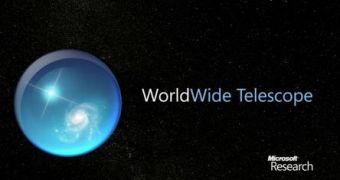It turns out that the secret Microsoft project aimed at changing the world will actually manage to point you toward the stars. From Microsoft Research, and courtesy of the work being done by Curtis Wong and Jonathan Fay, comes WorldWide Telescope, with the promise of permitting you to explore the universe from your desktop. Not accessible just yet, WorldWide Telescope falls under the same category of products such as the open source Stellarium and Google Sky, introduced in August 2007 via Google Earth. However, due to the new navigation technology enabled by the user interfaces, developed by Microsoft Research (think of Photosynth), exploring will be much more than just panning and zooming in and zooming out.
"The WorldWide Telescope (WWT) is a rich visualization environment that functions as a virtual telescope, bringing together imagery from the best ground and space telescopes in the world for a seamless, guided exploration of the universe. WorldWide Telescope, created with Microsoft's high-performance Visual Experience Engine, enables seamless panning and zooming across the night sky blending terabytes of images, data, and stories from multiple sources over the Internet into a media-rich, immersive experience," reads the description of the upcoming service.
For the time being, the service was made available only as a private alpha, and the promise from Microsoft is that WorldWide Telescope will be "coming in spring 2008." According to the Redmond company, the Visual Experience Engine technology is designed to deliver a seamless navigation user experience while exploring the WorldWide Telescope content. Microsoft has blended together not only terabytes of images of the night sky, but also additional data about the universe. The service will be made available for free to all users.
"WorldWide Telescope is an observatory on your desktop, allowing you to see the sky in a way you have never seen before; individual exploration, multi-wavelength views, stars and planets within context to each other, zoom in/out, and a capability for anyone to create and share a tour of the universe. The Visual Experience Engine delivers seamless panning zooming around the night sky. WWT delivers seamless integration of science:-relevant information including multi-wavelength, multiple telescope distributed image and data sets, and one-click contextual access to distributed Web information and data sources," Microsoft added.

 14 DAY TRIAL //
14 DAY TRIAL //